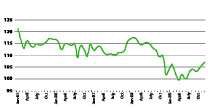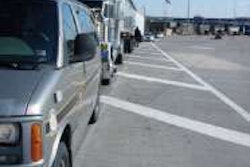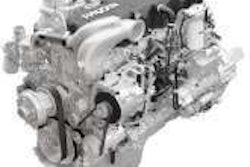The American Trucking Associations’ advance seasonally adjusted For-Hire Truck Tonnage Index climbed 2.1 percent in December, following a 2.6 percent increase in November. The latest gain boosted the SA index from 106.2 in November to 108.4 in December, its highest level since November 2008.
The nonseasonally adjusted index, which represents the change in tonnage actually hauled by the fleets before any seasonal adjustment, equaled 103 in December, up 2.3 percent from the previous month. Compared with December 2008, SA tonnage jumped 6.6 percent, which was the first year-over-year increase since September 2008. For all of 2009, the tonnage index was down 8.3 percent, which was the largest annual decrease since a 12.3 percent plunge in 1982.
 ATA’s Truck Tonnage Index (Seasonally Adjusted; 2000=100) ATA Chief Economist Bob Costello believes that tonnage is moving in the right direction, but he continues to be cautious about the future.
ATA’s Truck Tonnage Index (Seasonally Adjusted; 2000=100) ATA Chief Economist Bob Costello believes that tonnage is moving in the right direction, but he continues to be cautious about the future.ATA Chief Economist Bob Costello says that while tonnage jumped again on a month-to-month basis, the rate of increase may slow in the coming months. “The robust tonnage numbers in November and December were aided by better economic growth as well as a positive inventory effect,” Costello says. “However, economic activity is expected to moderate in the current quarter, which will keep a lid on tonnage growth.”
Costello also addressed the year-over-year gain in tonnage, the first in over a year. “While the index was moving toward positive year-over-year readings in recent months, December’s gain was due, in part, to a 7.8 percent plunge a year earlier,” he says. “There is no doubt that the industry is moving the right direction, but the level of freight will not be as strong as the year-over-year increases suggest because of how terrible it was in late 2008 and much of 2009.”
BTS updates Commodity Flow Survey
Final estimates from the 2007 Commodity Flow Survey released in late December show that the nation’s freight transportation system transported 12.5 billion tons of raw material and finished goods, valued at $11.7 trillion, accounting for nearly 3.3 trillion ton-miles during 2007. Trucking was the most dominant mode of transportation, accounting for 71 percent of the value, 70 percent of the tonnage and 40 percent of the ton-miles of the nation’s total freight shipment.
Shipments by rail accounted for more than 1.9 billion tons of goods and 15 percent of the total 2007 CFS tonnage, valued at nearly $436.4 billion. The rail mode was used to move goods about 1.3 trillion ton-miles, totaling 40 percent of all ton-miles.
CFS final data tables for 2007 along with survey documentation and methodology can be found at www.bts.gov/publications/commodity_flow_survey/. Data also are available at https://factfinder.census.gov/.
In brief
Freight Transportation Services Index rose 1.8 percent in November from its October level, rising after two consecutive monthly declines, according to the U.S. Department of Transportation’s Bureau of Transportation Statistics.
Congress in December extended the 65 percent subsidy of COBRA health insurance premiums to workers who lost their jobs in January and February, and everyone eligible for the subsidy now can receive it for up to 15 months. Employers must provide COBRA coverage to involuntarily terminated workers who agree to pay 35 percent of the premium. Employers are reimbursed for the other 65 percent by claiming a credit on their payroll tax returns. For more information, go to www.dol.gov/ebsa/cobra.html.
Trade using surface transportation between the United States and its North American Free Trade Agreement partners Canada and Mexico was 15.5 percent lower in October 2009 than in October 2008, dropping to $61.4 billion, according to the Bureau of Transportation Statistics of the U.S. Department of Transportation. NAFTA trade increased 7.2 percent in October 2009 from September 2009.
Old Dominion Freight Line increased its base rates by an average of 4.4 percent. The Thomasville, N.C.-based less-than-truckload carrier said the general increase was necessary to offset new equipment, new service centers and insurance costs, as well as wages and benefits.
Union Pacific Railroad says it achieved a record year of 1.25 million domestic intermodal shipments in 2009 due in part to the introduction of 43 new truck-competitive service products that allowed the railroad to capture freight that previously moved over the highway.










